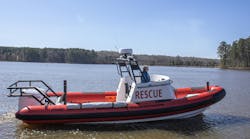Half of the roof and one side of a 45-foot semi-trailer were ripped off when the vehicle, loaded with 55-gallon drums of hazardous waste, smashed into a bridge on Interstate 40 outside of Flagstaff, AZ. Dozens of the drums were heavily damaged in the accident but no material was detected leaking to the environment. The incident took two days to resolve, requiring the closing of Interstate 40's westbound lanes.
The incident occurred when the driver of the fully loaded hazardous waste load apparently fell asleep. He received minor injuries in the violent crash, which destroyed the tractor and semi-trailer. The vehicle was placarded "Dangerous," and responding highway patrol officers could see the damaged drums of waste, due to the trailer being almost torn apart from the impact. They immediately closed Interstate 40, and summoned hazardous materials specialists.
Arizona has no county fire departments, and the Arizona Department of Public Safety's (DPS) Highway Patrol Bureau is the primary source of state-on-scene coordinators under the state's plan for hazardous materials emergency response. A commercial vehicle safety specialist was dispatched to the scene from Flagstaff and a hazmat specialist flown in from Phoenix, some 140 miles away. The helicopter carrying the Phoenix DPS specialist landed right on the closed lanes of the interstate.
The highway patrol district commander coordinated with the Coconino County Sheriff's Department, and arranged for evacuation of several dozen residences located within a half mile of the accident scene. Sheriff's deputies drove from house to house, notifying the residents, while highway patrolmen rerouted traffic off of Interstate 40. The sheriff's department further coordinated public information releases to the media, while DPS specialists worked within the scene itself.
The initial scene characterization entry was made from upwind with monitoring and detection instruments. Although there were clearly some severely damaged and punctured packages in the trailer, no visible evidence of leaks was encountered and the instruments did not detect any spilled materials. It was felt that the snow on the ground, and the cool air temperature that day helped prevent the formation of any significant vapors from any small amounts of product which may have leaked.
Once it was determined that the scene was stable, the trucking company was notified that it was now their responsibility to clean up the accident and make the hazardous waste packages safe for transportation. U.S. Department of Transportation (DOT) hazmat regulations contain specific provisions dealing with use of a "salvage drum" or "recovery drum" to overpack leaking packages so they can continue on to their destination.
The 49 Code Of Federal Regulations (49 CFR), Section 173.3(c), states: "Packages of hazardous materials that are damaged or found leaking and hazardous materials that have been spilled or leaked may be placed in a metal removable head salvage drum that is compatible with the lading and shipped or repackaging or disposal under the following conditions:
- The drum utilized may be either a DOT specification or a non-DOT specification drum as long as the drum has equal or greater structural integrity than a package that is authorized for the respective material in this subchapter. Maximum capacity shall not exceed 110 gallons.
- Each drum must be provided with adequate closure and, when necessary, provided with sufficient cushioning and absorption material to prevent excessive movement of the damaged package and to absorb all free liquid. All cushioning and absorbent material used in the drum must be compatible with the hazardous material.
- Each drum must be marked with the proper shipping name of the material inside the defective packaging and the name and address of the consignee. In addition, the drum must be marked 'salvage drum.'
- Each drum must be labeled as prescribed for the respective material."
A waste management contractor was selected for the cleanup by the carrier, and soon had several vehicles and a complete crew at the scene. Although initial monitoring had not detected any spilled material, cleanup crews working to remove drums from inside the heavily damaged trailer utilizing air supplied through a line back to a bank of cylinders. Each individual also had a five-minute escape air cylinder in case the primary air line supply failed.
Once the damaged drums were removed from the wreckage of the trailer, and it was definitely determined they were not leaking, the crews handling them utilized cartridge respirators for breathing protection. Any of the drums which were not in safe condition for continuing in transportation were overpacked in 85-gallon recovery drums. The 85-gallon recovery drums were then marked with the proper shipping name of the contents and DOT hazmat labels for the hazard class were applied, just the same as the original drum.
After the cleanup contractor personnel had thoroughly inspected the drums in the trailer and again detected no apparent leaks, individuals who had been evacuated from the nearby area were allowed to return to their homes. Periodic air monitoring continued to be conducted throughout the entire cleanup and repackaging operation but nothing was detected.
The majority of the hazardous waste 55-gallon drums contained smaller packages, varying from a few ounces to one gallon, surrounded in cushioning liquid absorbing material which filled the drums. This "protective" form of packaging prevented any of the inner containers from rupturing and discharging their contents.
After all of the drums had been taken out of the trailer, the wreckage of the vehicle was removed from the scene. The overpacking operation was completed within a few hours, and the cleanup contractor insured the original waste manifests matched the reloaded and heavily repackaged shipment.
Stephen L. Hermann is hazardous materials coordinator for the Arizona Department of Public Safety.










